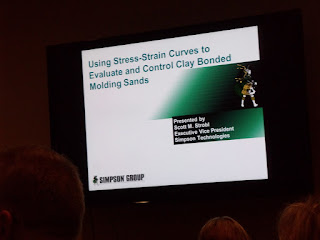Howdy doody from the Lone Star State,
Lots of good stuff to report, Daniel, the newest member of the global Synchro ERP team joined up with me last week for some intensive training at the office. We focused a lot on sales and he got to see several demonstrations.
We traveled over to Houston for several plant tours and sales calls. Just by chance, the AFS Texas Chapter was meeting and we attended all of the events. I think the highlight of the event was the Texas Troubleshooters meeting on sand. This isn't your ordinary beach sand mind you. The "green sand" that is used in metalcasting was the topic of discussion. Thinking about sand from a metalcasting standpoint, if you have sand problems to start with, then the resulting castings are going to have a variety of defects. Almost all casting defects can be traced back to sand and water.
So, why do metalcasters call it "green sand" when it is really black? It's because sand is such a "green - ecologically friendly product. Well, actually, no. Sand was used long long before anyone was concerned about recycling and being ecologically friendly. Green sand is called what it is due to the water content of the sand - not that the sand is green in color, but that it is like "green wood".
Why sand? Why is sand used in the metalcasting process? It's because the ancient Egyptians who came up with the whole metalcasting congress only had sand to work with... Well, not really, but it sounds good. Actually, sand is used because it has refractory properties - it doesn't melt at low temperatures and is a great insulator.
We learned a lot about the bentonite. Bentonite and I have a long history together. Many years ago, during my undergrad years, I spent my summers working on seismic field crews. Working in Wyoming in the Waukesha and Big Horn basinsup around Worland and Ten Sleep (ten sleeps from Ft. Laramie WY), I spent time traversing massive mountains and valleys of bentonite on the survey and jug-line teams. Hot summer sun on top of gray-black western bentonite.
When I worked at Texas Foundries, I hung out a lot in the sand and metalurgical laboraties and learned a lot about sand, clays, and metal. Watching the Methylene Blue test and working with the fines was always interesting.
Here are a few pictures of Houston event...
and until next time, see you on down the road.











No comments:
Post a Comment